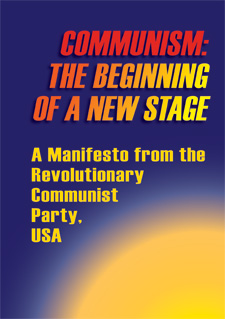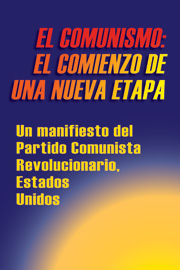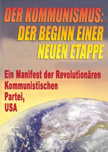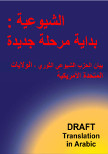U.S.-backed Brutal Repression in Egypt…
Needed: Real Revolution
September 1, 2013 | Revolution Newspaper | revcom.us
In January 2011, millions of Egyptians rose up in protest and rebellion against the 30-year-long regime of Hosni Mubarak—a brutal oppressor backed to the hilt by the rulers of the U.S.A. Mubarak’s police killed hundreds of protesters. But as protests grew in size and determination, Mubarak was driven from office and arrested for overseeing the murder of protesters.
The uprising, coming in the wake of one that overthrew a decades-old oppressive regime in Tunisia, sent shockwaves around the world, inspiring the oppressed and all who despised oppression, and sending the global powers-that-be, with the U.S. at the top of the heap, scrambling to figure out how to manage the challenge to the whole capitalist-imperialist order.
On July 3, 2013, with a green light from the U.S., General Abdel Fattah el-Sisi arrested Egypt’s elected president, Mohamed Morsi of the Muslim Brotherhood, and suspended the Egyptian constitution. At least 800 supporters of the Muslim Brotherhood have been killed, including prisoners executed in military custody, and thousands more arrested, and killings and arrests are continuing.
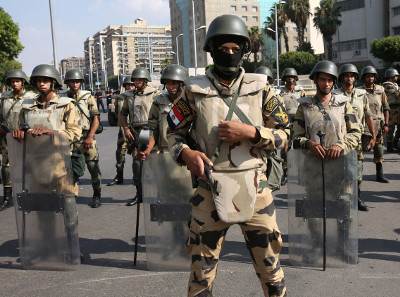
The Egyptian military—the largest in the Arab world—and a whole apparatus of spies, political police, and repression are backed by the USA, which sent $40 billion to Egypt over decades, much of it military "aid." Photo: AP
And on August 22, the butcher Mubarak himself was let out of jail where he was facing charges for—among other things—ordering the killing of protesters. His release is an outrage, and also an ominous symbol that the old-school enforcers of an oppressive order are back running Egypt.
The country is heading towards a one-sided civil war with forces around the reactionary military moving to crush the reactionary Muslim Brotherhood. Worst of all, the masses of people are either being aligned with one or another reactionary camp or rendered immobilized and on the sidelines. A deadly repressive calm is being imposed at the point of a gun. And the deeply felt and deeply rooted demands of the Egyptian people for freedom are as unmet as ever.
This is a critical moment to look reality in the eye, examine what brought things to this point, and BREAK OUT of a dead end, and deadly set of “choices” that led to the current situation.
Egypt Is in a World of Empire and Oppression
Mubarak’s three decades of draconian repression rested on the power of the Egyptian military—the largest in the Arab world, and a whole apparatus of spies, political police, and repression. Behind that, is the USA, which sent $40 billion to Egypt over the time of Mubarak’s reign, much of it military “aid” in one form or another. Under Mubarak, Egypt “developed” as a land of sweatshops and slums. Student activists, union organizers, and dissident intellectuals were kidnapped by the police, tortured, and dumped—sometimes dead, sometimes not—in the desert. Enlightened voices in culture were banned or driven into exile.
All this served well the interests of U.S. capitalism-imperialism. In the face of U.S. claims that it brings “democracy” to the world, Bob Avakian has said:
The essence of what exists in the U.S. is not democracy but capitalism-imperialism and political structures to enforce that capitalism-imperialism. What the U.S. spreads around the world is not democracy, but imperialism and political structures to enforce that imperialism. (BAsics 1:3)
And that is the essence of what the U.S. has brought to Egypt.
Egypt’s economy is not structured to serve the needs of the people of Egypt, but it answers to the demands of global capitalism-imperialism—mainly “The West.” As a result, poverty is epidemic—40 percent of Egypt’s population lives on $2 a day.
Egypt is dependent on and its economy is shaped by foreign investment, international loans, and Egypt’s subordinate integration into the world economy. Much investment capital entering into Egypt is concentrated in financial services and natural gas, sectors that generate huge profits and serve global imperialism but do little if anything to provide jobs or benefits for a significant section of the population.
Infrastructure, transportation and culture are driven by and serve tourism, foreign investment and domination. And Egypt—like other oppressed Third World countries—suffers a greatly disproportional impact of the global environmental crisis with terribly polluted air and water and previously fertile land ruined by unrestricted capitalist real estate speculation and “development.”
Foreign capital flows into super-profitable sweatshop production for export—especially cotton goods. The Egyptian military itself controls 40 percent of the economy. Agriculture has been left to rot. Despite favorable conditions for growing food, Egypt is the world’s largest importer of wheat.
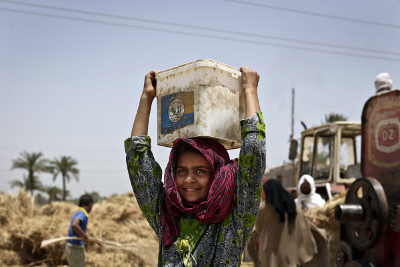
Egypt's economy is not structured to serve the needs of the people of Egypt, but it answers to the demands of global capitalism-imperialism—mainly "The West." As a result, poverty is epidemic—40 percent of Egypt's population lives on $2 a day. Above, a young woman works in the fields harvesting wheat 60 kilometers south of Cairo. Photo: AP
Beyond that, Egypt is a cornerstone in U.S. domination of the strategic Middle East. Egypt’s army collaborates with Israel to oppress the Palestinians which creates greater freedom for Israel to play the role of an outpost and enforcer for imperialism in the Middle East and beyond. The U.S. counts on access to Egyptian air space to wage its war in Afghanistan and to carry out its global “war on terror.” U.S. naval ships pass through the Suez Canal that runs through Egypt—four billion gallons of oil are shipped through the canal every day.
These and other strategic considerations are why U.S. aid and political support for the Egyptian military continues, even as it reveals the hypocrisy of claims that U.S. foreign policy is based on promoting “democracy.”
An Uprising for Freedom, but Framed by a Conflict Between Reactionary Poles
The millions of Egyptians who braved the gas and bullets of the Mubarak regime wanted freedom. They chafed at, and struck at, symbols of repression. Very importantly, women entered into the battle, although that was contentious even among the protesters.
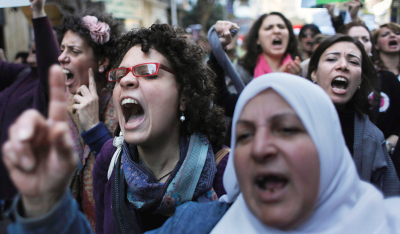
The millions of Egyptians who braved the gas and bullets of the Mubarak regime wanted freedom. They chafed at, and struck at, symbols of repression. Very importantly, women entered into the battle, although that was contentious even among the protesters. Above: Protesting in Cairo against post-Mubarak military rule on International Womens Day, March 8, 2012. Photo: AP
As people rose up, they sought solutions. They gravitated towards forces who, yes— had structures and organization in place—but more importantly, they cohered around or aligned themselves with one or another of the visions and models of what the world should be like that were contending in the field.
What were those forces and agendas?
Egypt is a big country, with 90 million people and a powerful military. What happens in Egypt was and is being closely watched and influenced to various degrees by a whole range of actors. The state of Israel—built on the ethnic cleansing of the Palestinians and serving as a regional and international enforcer for imperialism—shares a strategic border with Egypt. Neighboring reactionary states like Saudi Arabia and the oil-rich but tiny Gulf States have big stakes in how things develop in Egypt. They have poured billions of dollars into the country. And the turmoil in Egypt interacts with conflicts between the U.S. and its allies on the one hand and the Islamic Republic of Iran on the other. From Turkey and Syria to Tunisia and Yemen, “all eyes are on Egypt” in one way or another and many agendas are on the ground.
While these agendas do not boil down into a neat or exact alignment, right now, the decisive factor in shaping the conflict in Egypt, and shaping people’s (mis)understanding of possibilities is the clash between what are called “McWorld” and “Jihad.” These two, reactionary agendas are both contending with each other, and—as they do—reinforcing each other. That is the case in large parts of the world and within Egypt. Speaking of the current split in Egyptian society, an article from A World to Win News Service describes these two agendas this way:
“On one side stand the liberal proponents of the Western values marketed as ‘freedom’ especially the ‘free market’ that has crushed the vast majority of people in every country, and the corresponding belief in Western-style capitalist democracy and its system of elections that have never brought basic change anywhere. They have nothing but contempt and repression to offer the impoverished urban masses and most of the half of the population that lives in rural areas.”
And, “On the other side stand the Islamists, who claim to represent ‘freedom’ from Western domination, hypocrisy and humiliation while institutionalizing the backward economic and social relations and thinking that have helped keep Egypt weak and vulnerable to the domination of foreign capital. Their project is to combine exploitation, oppression and inequality with the false solace of religion, the hypocritical charity of the mosque and the suffocating solidarity of ‘the community of the faithful’ that abolishes critical thinking.” (“From A World to Win News Service on the Role of the U.S. in the Egyptian Bloodbath” at revcom.us.)
The Islamists, represented most prominently by the Muslim Brotherhood, sat out the uprising against Mubarak until the last minute. But in the post-Mubarak situation, they had the most organized networks, and were able to mobilize their base to elect Morsi as president. The Morsi regime was repressive and no improvement for the people. In the unsettled situation after the fall of Mubarak, the U.S. and the West were willing to tolerate and try to work through Morsi—for a time. As things developed, Morsi’s regime did not adequately serve the interests of the rulers of the U.S.
Morsi and the Muslim Brotherhood never intended to wrench Egypt free of the clutches of the world capitalist-imperialist system. Their aim was to restructure and re-divide some of the spoils passed out to imperialism’s local accomplices. But the Egyptian army was not willing to “share” those spoils or tolerate a restructuring that endangered their interests. Locked out, for the most part, from the key levers of real power—the courts, bureaucracy, and armed forces—the Muslim Brotherhood moved to stabilize and re-cohere society through Islamicization. And those moves, in turn, angered and alienated large sections society.
As anger grew against Morsi among many sections of the population, the proponents of Western-style capitalism were able to divert the anger of millions into what ended up being the July 3 military coup.
As A World to Win News Service wrote: “When these imperialists’ chosen local representatives saw their chance, the liberals dropped their rhetoric about majority rule, political rights and the rule of law and reached out to the ‘the nation’s armed forces’ that have never been the armed forces of the people and the nation as many so-called Marxists in Egypt claim. The military has always belonged to the imperialist-dependent Egyptian ruling exploiter classes, and spoon-fed and led by the nose by the U.S. for the last four decades.”
Egypt—and the World—Need Revolution
The essence of the problem in Egypt is that a revolution never took place. A revolution is not a protest. It is not a massive uprising. It is not a change in form of capitalist dictatorship. It is not whatever anyone wants to think it is. In today’s world, a revolution means the overthrow of the whole capitalist-imperialist system, and replacing that with socialism.
In an oppressed Third World country like Egypt, communist revolution unfolds on two levels. First, it involves a radical rupture with the world imperialist system, shattering the neocolonial state, which is the essential political-military control mechanism of imperialist domination, breaking with dependence on foreign investment, loans, and the whole logic of subordinating development to the needs of imperialism and breaking out of the network of exploitation and dependence—with all the suffering and distortion it brings about.
Second, this involves carrying out a profound social revolution that aims to mobilize the conscious activism of people to tackle and uproot all the oppressive relations of society—from the hold of religion, to the pervasive forms of patriarchy and male supremacy, to the inequalities bound up with the divisions between those who are trained to work in the realm of ideas and those who have been traditionally locked out.
Both aspects are essential and intertwined. You can’t do one without the other: you can’t break the vise-grip of imperialist domination if you don’t carry forward a social revolution that unleashes the determination and creativity of the masses; and you can’t carry out a social revolution if you remain ensnared in the network of imperialist relations.
This is a road of breaking free of imperialist domination as part of a revolution to get the whole planet beyond these horrors—as envisioned in Bob Avakian’s new synthesis of communism (to explore the new synthesis of communism, visit revcom.us/avakian).
Those who want that other way need to fight for it and, right now, fight to get it out into the world. In Egypt itself, the situation as described at the end of Bob Avakian’s statement on the 2011 uprising against the Mubarak regime still holds true:
It has frequently happened in history, as has been the case in Egypt (as well as Tunisia), that the domination of imperialism and the rule of local exploiters has taken a concentrated form in the regime of a “strong man” butcher. This was the case, for example, in Iran, with the torture-chamber rule of the Shah, in the Philippines with the tyranny of Marcos, and in Indonesia with the long monstrous reign of Suharto—all brutal dictatorships put in power and long kept in power by U.S. imperialism. In Iran in the late 1970s, in the Philippines in the 1980s, in Indonesia more recently, massive uprisings of the people forced the U.S. imperialists to throw aside these hated tyrants and to allow some changes. But in every case, the ultimate result was not one which led to real “freedom” for the people—instead they have continued to be subjected to cruel oppression at the hands of those who replaced the old, hated rulers, while these countries have remained within the overall framework of global imperialist domination and exploitation. But historical experience has also shown that the continuation of oppressive rule, in one form or another, is NOT the only possible outcome.
In Russia, in February 1917, another brutal despot, the Czar (absolute monarch), was overthrown by the uprising of the people. Here again, the U.S., British, and other imperialists, and the Russian capitalists, tried to continue the oppression of the Russian people in a new form, using the mechanisms of “democratic rule” and elections which, while allowing for some broader participation of different parties, would still be totally controlled by the exploiters of the people and would ensure their continuing rule, and the continued suffering of the masses of people. In this case, however, the masses of people were enabled to see through these maneuvers and manipulations, to carry forward their revolutionary rising, through many different twists and turns and, in October 1917, to sweep aside and dismantle the institutions and mechanisms of bourgeois dictatorship and to establish a new political and economic system, socialism, which for several decades continued to advance in the direction of abolishing relations of exploitation and oppression, as part of the struggle throughout the world toward the final goal of communism. The crucial difference was that, in the uprisings in Russia, there was a core of leadership, communist leadership, that had a clear, scientifically grounded, understanding of the nature of not just this or that ruthless despot but of the whole oppressive system—and of the need to continue the revolutionary struggle not just to force a particular ruler from office but to abolish that whole system and replace it with one that would really embody and give life to the freedom and the most fundamental interests of the people, in striving to abolish all oppression and exploitation.
Even though the revolution in Russia was ultimately reversed, with capitalism restored there in the 1950s, and today Russia no longer seeks to disguise the fact that it is a capitalist-imperialist power, the lessons of the Russian Revolution of 1917 hold valuable, indeed decisive lessons for today. And the most decisive lesson is this: When people in their masses, in their millions, finally break free of the constraints that have kept them from rising up against their oppressors and tormentors, then whether or not their heroic struggle and sacrifice will really lead to a fundamental change, moving toward the abolition of all exploitation and oppression, depends on whether or not there is a leadership, communist leadership, that has the necessary scientific understanding and method, and on that basis can develop the necessary strategic approach and the influence and organized ties among growing numbers of the people, in order to lead the uprising of the people, through all the twists and turns, to the goal of a real, revolutionary transformation of society, in accordance with the fundamental interests of the people. And, in turn, when people massively break with the “normal routine” and the tightly woven chains of oppressive relations in which they are usually entrapped and by which they are heavily weighed down—when they break through and rise up in their millions—that is a crucial time for communist organization to further develop its ties with those masses, strengthening its ranks and its ability to lead. Or, if such communist organization does not yet exist, or exists only in isolated fragments, this is a crucial time for communist organization to be forged and developed, to take up the challenge of studying and applying communist theory, in a living way, in the midst of this tumultuous situation, and to strive to continually develop ties with, to influence and to ultimately lead growing numbers of the masses in the direction of the revolution that represents their fundamental and highest interests, the communist revolution.
And that task—building genuine revolutionary communist leadership, and leading a revolution—can change everything.
COMMUNISM: THE BEGINNING OF A NEW STAGE
A Manifesto from the Revolutionary Communist Party, USA
Available in English, Farsi, German, Portuguese, Spanish and Turkish from RCP Publications, P.O. Box 3486, Merchandise Mart, Chicago, IL 60654
$5 + $1 shipping. A draft translation into Arabic is now available online. See all translations here.
If you like this article, subscribe, donate to and sustain Revolution newspaper.

